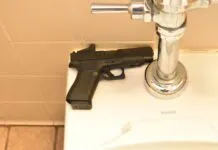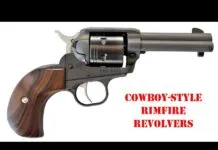The history of American 10mm service cartridges is a bit strange. We began with the right idea, got off on a tangent, and returned to the right idea. The right idea is a short-case 40-caliber cartridge suitable for use in handguns previously deemed 9mm sized. The premise of a .400-inch bullet in a moderately sized handgun was begun with the 40 Guns & Ammo round about 1972. A Browning Hi-Power 9mm was converted to fire a special short-case cartridge made by shortening a rifle case and fitting on it a 180-grain bullet. The result had a velocity of about 1000 fps. The bullet used was the same diameter as the one in the 38-40 revolver cartridge. Experiments were promising. There was a lot of interesting experimentation in those days, and the 40 G&A and the 38 Super Cooper were worthwhile loadings.
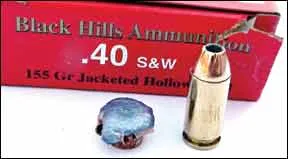
Somehow, the concept evolved into a longer cartridge with considerably more power. The 10mm auto could not be chambered in a 9mm-size handgun; instead it demanded a 45 ACP-sized frame. The 10mm Bren Ten debuted with a hot Norma loaded cartridge topping 1200 fps with a 200-grain bullet. The Bren Ten debacle is well documented. Colt resurrected the 10mm with the Colt Delta Elite, and the FBI first adopted then discarded the cartridge. Without shorting the many personalities and technicians involved, let us suffice to say that the 10mm was not the service cartridge of tomorrow, but it has survived with better distribution than the 41 Magnum, another round hailed as the police cartridge of tomorrow.
Afterward, the 40 Smith & Wesson was developed and shoehorned into a 9mm-size handgun. The 40 S&W is much closer to the original concept. While early 40s beat themselves to death, the design eventually worked. The short case required a small primer instead of the large pistol primer used in the 10mm, largely because the cartridge case rides rather close to the 9mm size ejector. You simply do not need to have an ejector close to a large pistol primer – ditto for the 45 GAP, another innovation and shoe horn job. The 40 battered some 9mm-size handguns, and even today, many believe 40 S&W handgun life is shorter than 9mm and 45 ACP handguns. The 40 suffers pressure spikes according to respected authorities, and this may be the cause of several well documented 40 S&W blow ups. Another cause may be the heavy use of lead bullets in a polygonal barrel. We have learned not to do this as pressure builds rapidly. With a cartridge already running at the top tier in pressure, a bit of bore restriction is all it takes to push the pressure envelope over the edge. The 40 develops high pressure like the 9mm, but also has a heavy bullet that has more momentum, further stressing the action. The 40 isnt alone in this regard. When the 357 Magnum revolver was current, cops used tons of soft lead wadcutters in training. Firing a few jacketed Magnums to clean the bore often cracked the forcing cone. You simply have to keep the bore clean in a high-pressure-cartridge handgun.
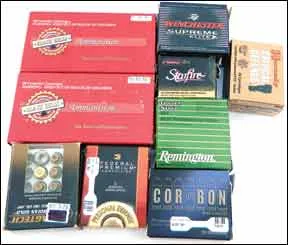
The bottom line most shooters want to get to is this: does the 40 Smith & Wesson offer enough advantages to overcome the shortfalls? The 40 may offer significantly greater recoil than the 9mm, but then much depends upon load selection. As an example, a Federal agency adopted the Glock 23 40 S&W and attempted to train officers to use the pistol well. They discovered that the pistol could not be controlled adequately enough to meet agency standards. They went to the Glock 19 shooting 9mm +P+ rounds. Were agency standards too high or was training inadequate? A good question.
Does the 40 S&W really split the difference between the 9mm and 45 ACP cartridges? We checked some data from recent tests to get a feel. A Remington Golden Saber 124-grain JHP 9mm we previously tested produced 1145 fps velocity, 360 foot-pounds energy, expanded to 0.57-inch diameter, and penetrated 12.5 inches in water. A Black Hills 45 ACP 230-grain JHP traveled 875 fps and produced 386 foot-pounds of energy. It expanded to a 0.72 inch diameter and penetrated 13.5 inches in water. In this test, a Black Hills 180-grain JHP (@ 1009 fps) walloped the 9mm and topped the 45 samples in energy, producing 406 foot-pounds (12% more than the 9mm and 5% more than the 45). It showed expansion to 0.70 inches and 20 inches of water penetration. It seems to us that the 40 is much closer to the 45 than the 9mm in performance. That is a good place to be.
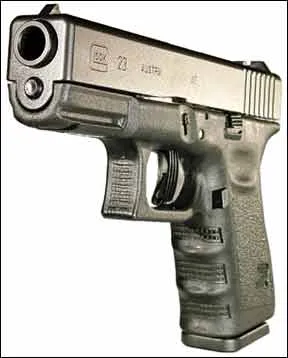
In any case, civilian shooters may choose any caliber they wish. So for them, the 40 must demonstrate greater wound ballistics to make the extra effort to control the round worthwhile. Another drawback is expense. When you consider bulk ammunition 9mm loads for training are much less expensive than 40s – a disparity that carries over to most personal-defense loads – many checkbooks wont support the 40. On another note, we have surveyed a number of professionals as to their choice of defensive sidearm. The consensus is that the 9mm is carried by those who want a lot of shots and the 45 by those who favor wound potential over capacity. Very few seem to carry a 40 on their own time and their own dime.
In this test, what we wished to do is to provide good information to make an intelligent decision. The bottom line is reliability. The ammo must go bang every time. Then, the load must be controllable in relation to others in the same caliber. Accuracy is relative to the mission of self protection.
We elected to test the 40 Smith & Wesson with a number of popular loadings. We tested ammunition with projectiles ranging from 135 to 180 grains. This gives the shooter a good understanding of the levels of performance available. We noted that the selected 40 S&W rounds do not exhibit the high deviation in penetration found in our earlier 9mm tests, which may show more than 100% deviation, with penetration from 5 to 14 inches in qualified testing. The 40, we found, is more consistent. In this area, the 40 is more similar to the 45 ACP than the 9mm. In the past, a consensus existed that deemed that a handgun cartridge needed to be a least 40 caliber with a velocity of 1000 fps and a bullet weight of 200 grains to be effective. The 38-40 revolver round with its .401-inch bullet, the 10mm auto, and the 41 Magnum meet these criteria. The factory 40 loads dont quite deliver the whole enchilada – although with careful handloading, 200 grains at 1000 fps is a possibility. Still, in our opinion, an expanding 180-grain bullet at almost 1000 fps is pretty impressive.
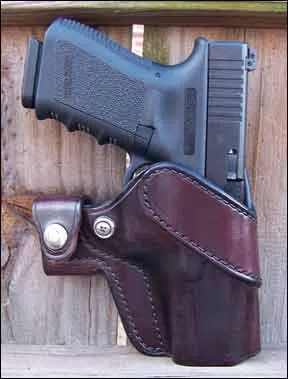
There is a wide choice in handgun selection for the 40 S&W cartridge, ranging from the lightest compacts to full-size service pistols. While the easiest-to-use pistols are the heaviest, we decided to fire a compact that has been around the block a time or two, dropped on the road and generally had a hard life but never failed. A Glock 23 has proven accurate and reliable with rough and ready written all over it. Its also more like a pistol you would carry concealed.
As noted above, we tested several bullet weights. The 180-grain 40 S&W is the original weight. Naturally, the 165-grain load is thought to be a compromise between the 155- and 180-grain weights. Often, 165s are loaded lighter than the 180s and have a reputation as the easiest loads to control. In this test, however, we got a trio of starchy 165s from Winchester, Remington, and Hornady that produced the highest energies in the test. The 155-grain load is the original lightweight bullet for those who want a faster-stepping round with greater velocity and potentially more bullet upset. For highest-velocity fans, the 140- and 135-grain loads from Cor-Bon didnt disappoint. Heres how our test selections performed.
Black Hills D40N220 180-grain JHP, $16.87/20
The Black Hills load demonstrated greater velocity than most 180-grain loads we have tested, with velocity consistently well over 1000 fps. Standard deviation was among the lowest of any we tested. We were impressed with the accuracy (2-inch average) and clean burn of this loading. Penetration was on the long end (20 inches in water) and the bullet plumped up and expanded (0.70 inch) with uncanny consistency. Control was not difficult. This would be our pick as an all-round service load for police work or field use. Cost: 84 cents/round.
Gun Tests Grade: A
180-grain JHP, $19.62/20
The Magtechs are supposed to be economy loads. The load was reliable as far as feed and function. Accuracy was the worst in the test (4.0 inches). The bullets penetrated the most (24 inches) and expanded the least of any of the heavier loads (0.66 inch). You have to decide if mediocre accuracy is acceptable, and if the price of the load is an overwhelming factor. Cost: 98 cents/round.
Gun Tests Grade: B
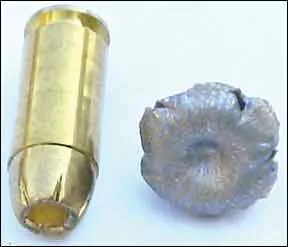
PMC Starfire 40SFA 180-grain HP, $18.73/20
The Starfire is an interesting design that has been around some time. The Starfire fed, chambered, fired, and ejected reliably, with one exception. A bullet nose was pressed into the case during the manual feeding test we do in preparation for firing. The bullet was butted into the case on the third chambering. Accuracy was the second-worst (3.5 inches) demonstrated during the test program. Velocity was the lowest (901 fps). Penetration and expansion were acceptable. Cost: 94 cents/round.
Gun Tests Grade: D
Winchester PDX1 Defender WINS40SWPDB 165-grain HP, $20.99/20
This is a consistent load with a full powder burn resulting in almost no muzzle signature. There was a minimum of unburned powder. This load ran smoothly. Accuracy was remarkably consistent across the board with the 165-grain loads, but the Winchester delivered the best accuracy of the test (1.75 inches). The Winchester had the second-highest expansion (0.72 inch) and the second-highest energy in the test. Cost: $1.05/round.
Gun Tests Grade: A
Remington Premier Golden Saber GS40SWA 165-grain BTHP, $33.99/25
The Golden Saber uses a unique brass jacket over a soft lead core. Feed reliability is enhanced by this design, although in our experience, the 40 S&W, the first cartridge designed specifically for JHP ammunition, is very feed reliable. The Golden Saber is consistent and offers good performance. Expansion was the greatest of any load tested, but this includes an extension of the brass jacket, which made the bullet mike out at 0.80 inch. Without the extension, however, the Golden Saber still went about 0.75 inch. With a combination of five extra rounds and good performance, this is arguably the best self-defense round in the test, but its also pricey. Cost: $1.36/round.
Gun Tests Grade: A-
Hornady Critical Defense HDY91340 165-grain FTX, $19.99/20
The FTX bullet design is intended to promote feed reliability since the hollow-point cavity is covered. The bullet is designed to expand by pressing the polymer tip into the bullet. The process works. The FTX had the lowest velocity of the 165-grain loads, but was the third most-accurate bullet of that set. Control in rapid fire was noticeably better with this 165-grain load that with the hot lightweight bullets or the 180-grain bullets.
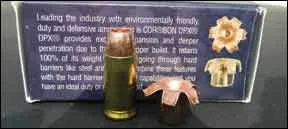
Our team said this is a credible choice for personal defense. Cost: $1/round.
Gun Tests Grade: B+
Black Hills D40N120 155-grain JHP, $16.87/20
The Black Hills 155-grain JHP proved accurate (2.0 inch) and consistent. Felt recoil was less than its heavier stablemate, but neither was a chore to control. The 155-grain JHP predictably penetrated less than the 180-grain load (18 inches), and expansion (0.71 inch) was not on the par with the 180-grain load, although still quite good. If you have a need for an urban load or believe 180-grain penetration is too much, the 155-grain Black Hills load is a good choice. Based purely on economy versus performance, this is a best buy. Cost: 84 cents/round.
Gun Tests Grade: A (Best Buy)
Federal 155-grain Hydra-Shok FEDP40HS2, $23.99/20
This is a classic loading that has been around a while, and quality control, accuracy, and powder burn cannot be faulted. It was slightly slower than the Black Hills load, but penetration and expansion were practically equal. In our opinion, the Hydra Shock is never a bad choice. This load is among the better all-round choices for personal defense in 40 caliber. But it takes a backseat to the Black Hills 155 on affordability. Cost: $1.20/round.
Gun Tests Grade: A-
Cor-Bon Self-Defense 40135 135-grain JHP, $27.63/20
This loading is designed to maximize your pistols output. The lightweight bullet exited our Glock Model 23 at a sizzling 1338 average. Surprisingly, recoil was not appreciably greater than the 180-grain loads, as reflected in the power factor ratings (181 for the Cor-Bon versus 182 for the 180-grain Black Hills round). There were no excess-pressure signs. Accuracy was in the bottom third (3.0 inches).
The big show is ballistic performance. The 135-grain bullet expanded quickly and shed bullet weight as well. Penetration was limited, which is desirable to some shooters and in certain situations. For those worshipping the high-velocity totem, this is an impressive loading. Notably, this load typically knocked water jugs rearward in line, even though it did not penetrate all that deeply (12 inches). Cost: $1.38/round.
Gun Tests Grade: A-
Cor-Bon DPX 40140 140-grain Solid Copper HP, $36.11/20
Definitely a pricey choice, but the performance of this load cannot be faulted. More than one experienced shooter has proclaimed that they prefer the DPX bullet and loading to all others. Their strategy is to use inexpensive loads for practice and carry the best they can afford. Hard to fault the logic. Penetration (18 inches) and expansion (0.69 inches) are there in a good balance. Accuracy (2.5 inches) is good. This is an interesting load that offers a modern option of being totally lead free – and you pay for it. Cost: $1.80/round.
Gun Tests Grade: B
Our Team Said: The Black Hills 155-grain JHP is a Best Buy. There are a number of good loads in this test, and the raters found it difficult to reach a consensus on the one best load. So they considered price as part of the final decision, as well as determining the 155-grain loads were more in line with the performance with what seem more desirable for personal defense. Its also hard to overlook the Winchester 165-grain choice because of its best-of-test accuracy, high energy, and near-ideal (in our opinion) penetration at 16 inches. The Remington Golden Saber had a great showing and also is priced affordably. Among the 180s, Black Hills was the clear winner and remained a pretty good value. The Cor-Bon loads are unique and fill a need for urban use, with the DPX 140 providing the penetration we like with good expansion and accuracy. It was the most expensive load tested, however. Surprisingly, the 135-grain Cor-Bon topped the energy readings without being hard to control.
Written and photographed by R.K. Campbell, using evaluations from Gun Tests team testers. GT



